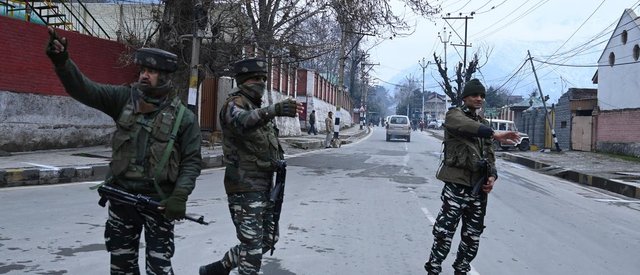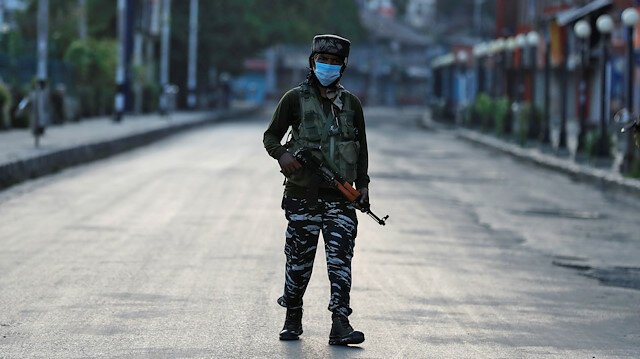The Slavery Voice ( WARNING : THE POST IS FOR 17+ )
This article is about Human rights abuses in the Indian-administered portion of Kashmir.
Human rights abuses in Jammu and Kashmir state are an ongoing issue. The abuses range from mass killings, enforced disappearances, torture, rape, and sexual abuse to political repression and suppression of freedom of speech. The Indian Army, Central Reserve Police Force (CRPF), Border Security Personnel (BSF), and various separatist militant groups have been accused and held accountable for committing severe human rights abuses against Kashmiri civilians.

NOTE: I don't have copyright authorization of image.
Some rights groups say more than 100,000 people have died since 1989 while the official figures from Indian sources state the estimates of the number of civilians killed due to the insurgency as above 50,000. In a 1993 report, Human Rights Watch stated that Indian security forces "assaulted civilians during search operations, tortured and summarily executed detainees in custody and murdered civilians in reprisal attacks"; according to the report, militants had also targeted civilians, but to a lesser extent than security forces. Rape was regularly used as a means to "punish and humiliate" communities. Scholar Seema Kazi says it is used as a weapon of war by the state against the population.
Indian Armed Forces:
Thousands of Kashmiris have been reported to be killed by Indian security forces in custody, extrajudicial executions, and enforced disappearances and these human right violations are said to be carried out by Indian security forces under total impunity. Civilians including women and children have been killed in "reprisal" attacks by Indian security forces. International NGOs, as well as the US State Department, have documented human rights abuses including disappearances, torture, and arbitrary executions carried out during India's counter-terrorism operations. Human Rights groups have also accused the Indian security forces of using child soldiers, although the Indian government denies this allegation.
At the Asia-Pacific Conference on the Use of Children as Soldiers in May 2000 the representative of the state government of Jammu and Kashmir denied the involvement of children in VDCs. He acknowledged that there may have been some instances of young boys taking up arms to defend themselves under attack, but that there was "no policy to encourage young boys to become members of the Village Defence Committees." Torture, widely used by Indian security sources, whose severity is described as beyond comprehension by Amnesty International, has been responsible for the huge number of deaths in custody.

NOTE: I don't have copyright authorization of image.
Exodus of Kashmiri Hindus:
The Hindu Kashmiri Pandits, a small but prominent group, had been a favoured section of the population during Dogra rule (1846–1947). About 20 per cent of whom had left the Kashmir valley by 1950 after the land reforms. began to leave in much greater numbers in the 1990s. According to several authors, approximately 100,000 of the total Kashmiri Pandit population of 140,000 left the valley during that decade. Other authors have suggested a higher figure for the exodus, ranging from the entire population of over 150,000 to 190,000 of a total Pandit population of 200,000 to a number as high as 253,000. The US government has reported on the terrorist threat to Pandits still living in the Kashmir region.
The alleged rigging of the 1987 Assembly Elections by the ruling party, National Conference, saw the rise of an armed rebellion among Kashmiris associated with the Muslim United Front (MUF), a conglomerate of several Muslim political organisations opposed to National Conference. During the eruption of the armed rebellion, the insurgents are reported to have specifically targeted the Pandits, with torture and killings. Reports by Indian government state that 219 Kashmiri Pandits were killed from 1989 to 2004 and around 140,000 migrated due to militancy while over 3000 stayed in the valley. The local organisation of Pandits in Kashmir, Kashmir Pandit Sangharsh Samiti after surveying in 2008 and 2009, claimed that 399 Kashmiri Pandits were killed by insurgents from 1990 to 2011 with 75% of them being killed during the first year of the Kashmiri insurgency. Motilal Bhat, the president of the Pandit Hindu Welfare Society, rejected the figure of 399 killed and said that only 219 were killed.
Kashmiri separatists believe that the then Governor Jagmohan encouraged the exodus of Kashmiri Pandits from the Valley by deliberately creating an atmosphere of paranoia. This, they claim, was done to "facilitate the counter-insurgency" operations and suppressing the anti-Indian uprising in Kashmir. The mass migration of Kashmiri Pandits from the Valley started on 19 January 1990 immediately preceding the first massacre of Kashmiri Muslims at Gawakadal. The Gawakadal massacre was followed by eight other major massacres and allegations of fake encounters, enforced disappearances, tortures and crackdown operations. Pro-India commentators have refuted this version as a false allegation "to hide the truth".[citation needed]
Our people were killed. I saw a girl tortured with cigarette butts. Another man had his eyes pulled out and his body hung on a tree. The armed separatists used a chainsaw to cut our bodies into pieces. It wasn't just the killing but the way they tortured and killed.
The violence against Kashmiri Pandits was condemned and labelled as ethnic cleansing in a 2006 resolution passed by the United States Congress. It stated that insurgents infiltrated the region in 1989 and began an ethnic cleansing campaign to convert Kashmir to a Muslim state. According to the same, the population of Kashmiri Pandits in Kashmir had declined from 400,000 in 1989 to 4,000 in 2011. Historian Mridu Rai says that such high numbers are not credible because the total Kashmiri Pandit population was only 160,000 to 170,000 at the time of their departure.
The CIA has reported nearly 506,000 people, about half of which are Pandit Hindus are displaced due to the insurgency. The United Nations Commission on Human Rights reports that there are roughly 1.5 million refugees from Indian-administered Kashmir, the bulk of whom arrived in Pakistan administered Kashmir and in Pakistan after the situation on the Indian side worsened in 1989 insurgency.
Post-1989, Kashmiri Pandits and other minority groups in Jammu and Kashmir have been targets of jihadi elements which India alleges and blames on the Inter-Services Intelligence. The Kashmiri Pandits, a community of Hindu Brahmins, then comprising 5% of the population of the state were the primary targets of Islamic militants, who also sought to eliminate Kashmir's record of 5000 years of Hindu Sanskrit culture and scholarship as well as the tolerant indigenous multiculturalism referred to as Kashmiriyat. As many as 170,000 Kashmiri Pandits are estimated to have fled the state due to being targeted and threatened by militant groups. In 1989, attacks on Pandits escalated and Muslim paramilitaries selectively raped, tortured and killed Kashmiri Pandits, burnt their temples, idols and holy books. The Pandits fled en masse from the state after which their houses were burnt by militants and their artwork and sculptures were destroyed.
In August 2000, militant groups killed 30 Hindu pilgrims in what became known as the 2000 Amarnath pilgrimage massacre. The Indian government blamed the Lashkar-e-Taiba for the killings. The BBC writes that "hundreds of Hindu labourers ha[d] been leaving the Kashmir Valley" in August 2000 due to targeted killings against Hindu workers.
Other minorities such as Kashmiri Sikhs were also targeted. According to Chitkara, the killing of Sikhs near Anantnag in 2001, by the Jehadis was aimed at ethnic cleansing. Hindus have migrated from most of the Kashmir valley, Sikhs who form a very small percentage could be forced to migrate in the wake of such killings. The Lashkar-e-Taiba has been blamed by the Indian government for the Chittisinghpura massacre, which killed 36 Sikhs at the time of Clinton's visit to India. In 2010, the Lashkar-e-Taiba (LeT) associate David Headley, who was arrested in connection with the 2008 Mumbai attacks, confessed to the National Investigation Agency that the LeT carried out the Chittisinghpura massacre.